The A27L Centaur Mark IV Tank
This preserved British Centaur Mark IV tank can be found at Cobbaton Combat Collection Museum, Chittlehampton, Umberleigh, North Devon, England. www.cobbatoncombat.co.uk. The paint would either be SCC No.2 (Khaki Brown) or SCC No 15 (Khaki Green).
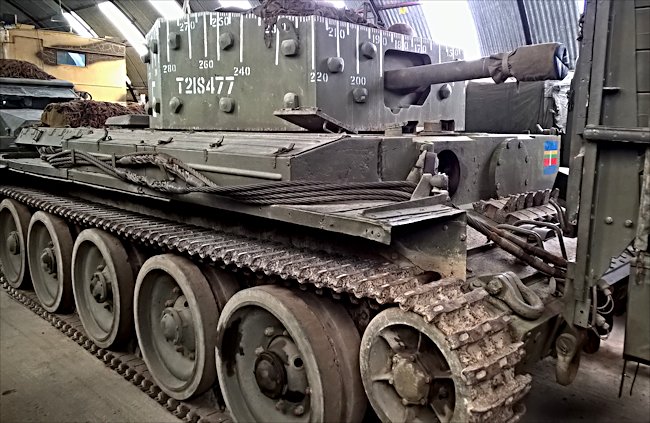
British Centaur Mark IV 95mm Tank at the Cobbaton Combat Collection Museum in Devon
Initially the Centaur Mark IV tank was going to go to war without an engine. The idea was that two tanks would stay in a landing craft just off the D-day beaches and use their 95mm howitzer cannons to pound the German gun emplacements and machine gun nests with HE high explosive rounds as the Royal Marines attacked the Normandy beaches. After a number of protests the tanks were fitted with engines so they could follow the troops inland and offer close infantry support against enemy strong points. The Mark IV Centaur is the only version to see action in WW2.
The Royal Marines Armoured Support Group was disbanded on D+14. Their Centaur Mk IV Close Support tanks were then distributed to other units. Some were issued to the Free French, 13e Régiment des Dragons, where they saw no action. Some were also in use by 6th LAA Battery, 27th Light Anti-Aircraft Regiment, RA (attached to 51st Highland Division) until 30/7/44. They were then transferred to the Canadians on 6th August 1944 in support of 6th Airborne Division, where they formed 'X' Armoured Battery, 53rd Light Regt., RA and the 1st Canadian Centaur Battery, RCA. I believe that the French Army ended up with them after that which may be why one of the four surviving Centaur MkIV tanks can be found in the French Tank Museum in Saumur. Their involvement with the Royal Marines was limited to two weeks.
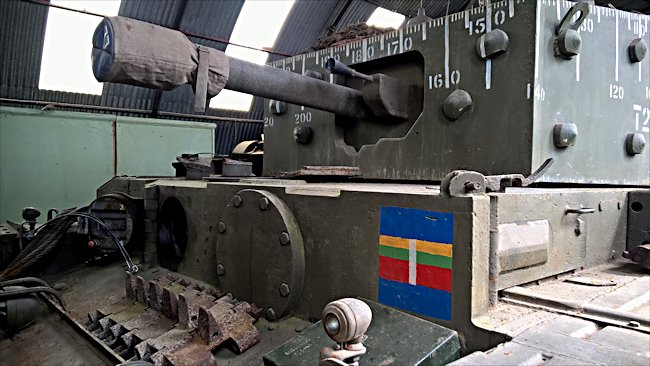
British Centaur Mark IV 95mm Howitzer and machinegun
The Centaur Cruiser Tank Mark IV tank was built by Leyland. Originally it was designed to be powered by a Merlin aircraft engine similar to the one fitted in RAF Spitfire fighters. The Merlin engine could not be built in sufficient numbers to match demand so the tank designers looked for an alternative engine and found a supply of Liberty aircraft engines. It was not as powerful as the Merlin engine. It was originally designed in WW1 in the United States in 1917. It powered a number of different WW1 aircraft as well as the Anglo-American Liberty WW1 Mark VIII tank.
The engine continued to power aircraft and tanks during the 1920s and 30s. When WW2 broke out it was used as the power plant for the British Cruiser A13 and Crusader A15 tanks as well as the Centaur Mk III tank. A Liberty L-12 V12 27 litre petrol engine was fitted to the Centaur MkIV tank. It only produced 395hp compared with the V12 27 litre Merlin engines fitted in the Cromwell tanks that were capable of producing 600hp. The Liberty engine was built by the British company Nuffield. It suffered numerous mechanical problems with cooling and reliability. It had a fuel consumption figure of 0.6mpg and a maximum official road speed of 28mph but it is rumoured that it could reach 50 mph after its speed governors had been doctored. The tank used a 5-speed Merrit brown gearbox manufactured by David Brown.
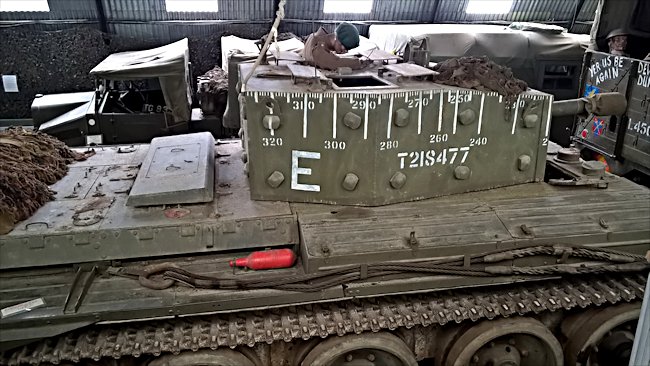
Side view of the D-day Centaur MkIV Tank
The Centaur MkIV tank in the Cobbaton Combat Collection was built in 1944. After WW2 it was converted into a Centaur Bull Dozer tank by the Army in July 1945. The turret was removed and a huge metal blade was added to the front of the tank that could be raised up and down by the adjustment of two long metal arms that ran down the whole length of the tank. It was sold as scrap in 1957 and remained at the Pound's Military Scrap Yard in Portsmouth until Preston Isaacs of Cobbaton Combat purchased the tank hull in 1979.
It had damage to the 'tin metal work' on the top of the tank because a Churchill tank had been parked on top of it for a number of years. This had to be removed before Preston could transport his new tank restoration project to its new home in North Devon. There were a number of other Centaur tanks rusting away in Pound's Yard at the time. Parts of their upper body 'tin work' that was in a good condition was used to restore this tank.
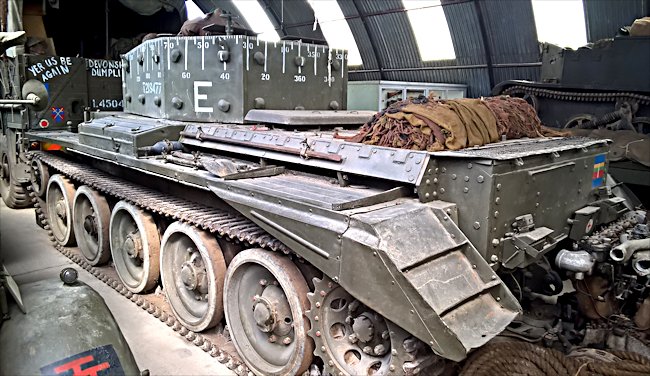
British Centaur Mark IV CS Tank
Preston Isaac used his engineering and metal work skills to fashion a mock up of a Centaur tank turret and 95mm gun. This enabled visitors to get an impression of what the Centaur MkIV tank looked like when it went into battle on D-Day. Isaac managed to pick up a Centaur tank turret from the British Army firing ranges on Salisbury Plain. This is where the turrets were sent when the tank hulls were converted into bull-dozers. You can see the turret outside the main hangers at the Cobbaton Combat Collection. It is chained to two unexploded sea mines. Preston's son Tim Isaac hopes to restore the turret and fit it to the hull of the tank. Does any one know of a spare 95mm Centaur howitzer? The tank was restored to a running condition.
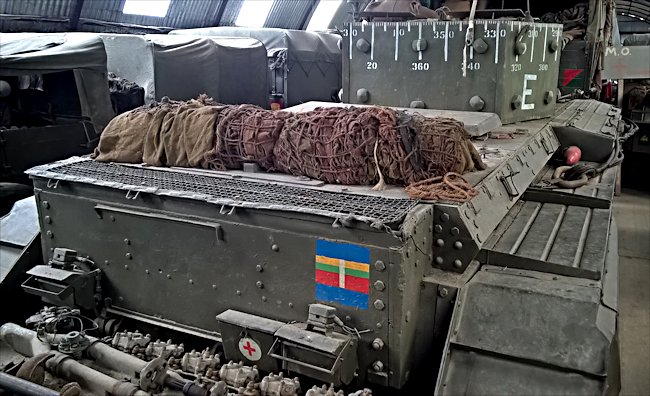
Rear view of Royal Marines Armoured Support Group Centaur Mark IV Tank
Inside the tank are two manufacturers chassis plates. The first one relates to when the tank was first produced by Leyland in 1944. Its manufacturing number is 72 and the type is shown as the letter D. This is not D for dozer. D is the fourth letter of the alphabet which matches the designation Mark IV. The tank's vehicle registration number, its Army identification 'number plate', was T11243 which is still painted on the outside of the tank today. The second manufacturing plate inside the tank relates to its conversion into a bull-dozer in 1945.
The Royal Marines Armoured Support Group Centaur MkIV tank turrets had the degrees of a compass painted around them in white. The 360° marker was at the rear and the 180° marker that indicated South, was at the front. These were added to help the centaur lay down covering fire while still on the landing craft as they approached the beach. The Royal Marine spotter would call out the degree and distance to the target and the tank gunner would fire blind over the front of the landing craft ramp.
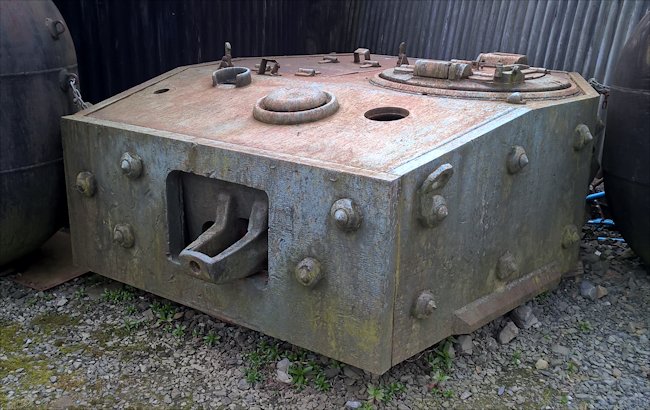
Centaur Mark IV Tank turret awaiting fitting on the Cobbaton tank hull. It needs a 95mm Howitzer.
Where can I find other preserved Centaur Tanks?
- Cobbaton Combat Collection, England
- French Tank Museum, Saumur, France
- 2nd Lancers Regiment Barracks, Calcada da Ajuda, Lisboa, Portugal
- 2x Portuguese Army Cavalry School Museum, Santarem, Portugal
- Armrd Weapons Museum, Land Forces Training Centre, Poznan, Poland
- 2nd Lancers Regiment Barracks, Calcada da Ajuda, Lisboa, Portugal
- Hellenic Army Armor Museum, inside the Armor Training Center, Avlona, near Athens, Greece
- Command Tank - Imperial War Museum Duxford, England
- Dozer Tank - Private Collection, England
- Dozer Tank wreck - Private Collection, England
- Under restoration - Kevin Powles Collection, England
- Command Tank - Imperial War Museum Duxford, England
- 4x Centaur wrecks - England
- Centaur wreck - Oberhoffen-sur-Moder, France
- Centaur replica - Hermanville-sur-Mer, Normandy, France
- Source - Pierre-Oliver Buan - http://the.shadock.free.fr/Surviving_Panzers.html
WW2 British Tank books

